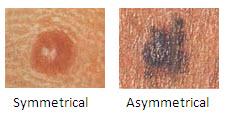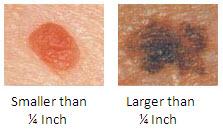 It's the first day of summer and the sunbathers are out in force. What steps should be taken to protect your skin, and what are some warning signs of cancer? We hear from local dermatologists on Chicago Tonight at 7:00 pm.
It's the first day of summer and the sunbathers are out in force. What steps should be taken to protect your skin, and what are some warning signs of cancer? We hear from local dermatologists on Chicago Tonight at 7:00 pm.
What is Skin Cancer?
Skin cancer is the uncontrolled growth of abnormal skin cells. It occurs when unrepaired DNA damage to skin cells (most often caused by ultraviolet radiation from sunshine or tanning beds) triggers mutations, or genetic defects, that lead the skin cells to multiply rapidly and form malignant tumors. Cancerous tumors may spread, invading and damaging nearby tissue. In some cases, skin cancers can spread to vital organs, becoming deadly.
Skin cancer is the most common form of cancer in the United States. Early detection is key to treatment and survival of the disease. The Skin Cancer Foundation recommends monthly head-to-toe self examinations. Follow the step-by-step instructions below. You will need a bright light, a full-length mirror, a hand mirror, 2 chairs or stools, a blow dryer, body maps and a pencil.
Self-Examination Steps
1) Examine your face, especially the nose, lips, mouth, and ears - front and back. Use one or both mirrors to get a clear view.
2) Thoroughly inspect your scalp, using a blow dryer and mirror to expose each section to view. Get a friend or family member to help, if you can.
3) Check your hands carefully: palms and backs, between the fingers and under the fingernails. Continue up the wrists to examine both front and back of your forearms.
4) Standing in front of the full-length mirror, begin at the elbows and scan all sides of your upper arms. Don't forget the underarms.
5) Next focus on the neck, chest, and torso. Women should lift breasts to view the underside.
6) With your back to the full-length mirror, use the hand mirror to inspect the back of your neck, shoulders, upper back, and any part of the back of your upper arms you could not view in step 4.
7) Still using both mirrors, scan your lower back, buttocks, and backs of both legs.
8) Sit down; prop each leg in turn on the other stool or chair. Use the hand mirror to examine the genitals. Check front and sides of both legs, thigh to shin, ankles, tops of feet, between toes and under toenails. Examine soles of feet and heels.
The ABCDE's of Melanoma
A change in size, shape, color or feel of an existing mole often indicates the first signs of melanoma, the most dangerous form of cancer. Keep a close eye on your body and remember “ABCDE” when evaluating a mole for potentially dangerous characteristics.
 ASYMMETRY: take note of moles where the shape of one half of the mole does not match the other. If you draw a line through this mole, the two halves will not match.
ASYMMETRY: take note of moles where the shape of one half of the mole does not match the other. If you draw a line through this mole, the two halves will not match.

BORDER: watch for moles where the edges are ragged, notched, blurred, or irregular in outline. The borders of an early melanoma tend to be uneven.

COLOR: watch for moles where the color is uneven, multiple colors or very dark brown or black.

DIAMETER: watch for a change in size, especially an increase. Melanomas usually are larger in diameter than the size of the eraser on your pencil (1/4 inch or 6 mm), but they may sometimes be smaller when first detected.

EVOLUTION: watch for any changes in size, shape, color, elevation, or another trait, or any new symptom such as bleeding, itching or crusting.
Source: Skin Cancer Foundation


